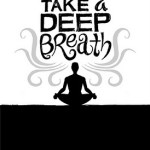As you are sitting in front of your computer right now, take a moment to check your posture. You are probably slouching slightly in your seat, your shoulders are rolled forward, and your head and neck are protruding. While you are sitting in this position, try this simple exercise: take a deep, long, belly breath. Did you notice how much effort it took? Did it feel unnatural? Now, sit back in your chair, lower your shoulders from your ears, tuck in your chin, and repeat the breath. Notice how much more depth you were able to achieve, and how much more fulfilling the breath was! Most people agree that maintaining good posture is important, but they may not know the implications for their health.
The simple exercise above demonstrates how poor posture can affect your breathing. People that sit at a desk for an extended period of time are particularly vulnerable. These people will gradually slouch, assuming the posture above, and eventually their breathing becomes shallow and quick. Shallow breathing utilizes accessory muscles in your neck and shoulders, which can lead to fatigue, neck pain, and tension-type headaches.
Rolling the shoulders forward puts increased tension between the shoulder blades, which accentuates the natural curve in the upper spine. This leads to chest tightness, weakness of the shoulder girdle, and it often irritates the rib cage, again, leading to short and shallow breathing.

It is essential that we retrain our posture and relearn how to breathe.
The importance of core-breathing is mostly discovered in practicing yoga. Many of the classes focus on breathing from the lower belly, sometimes even placing the hand near the diaphragm to emphasize where the breath should originate. Some difficult postures require slow and steady breaths. During shavasana, or meditation, the body seems to demand long, deep, fulfilling breaths to clear the mind and relax the muscles.
Be aware of your breath and posture. Check yourself in the mirror. From the side, your ear should align with your shoulder, which should align with your hip, which should align with your knee, which should align with your ankle. Begin trying these simple habits, and incorporate them into your routine:
Set an alarm for every 20 minutes while you are sitting at a desk to remind yourself to get up, stretch, and hydrate.
Place your hand on your abdomen and practice deep, diaphragmatic breathing.
Occasionally switch up your desk chair for a Swiss ball.
While walking, imagine you are holding a 10 lbs. weight in each hand to remind yourself to drop your shoulders down.
Perform simple chin-tucks while you are sitting at a red light.
Take in a yoga class, and concentrate more on your breath than on how awkward you look
Breathing is fundamental to life. Oxygen nourishes our tissues. We take our breath for granted. Become more aware of your posture, and just breathe.
Info Credit: Google Health



